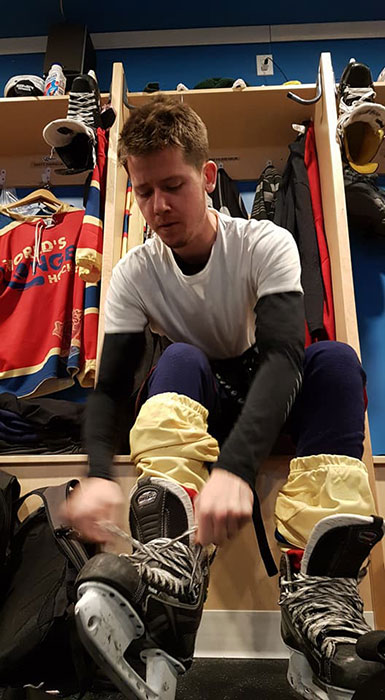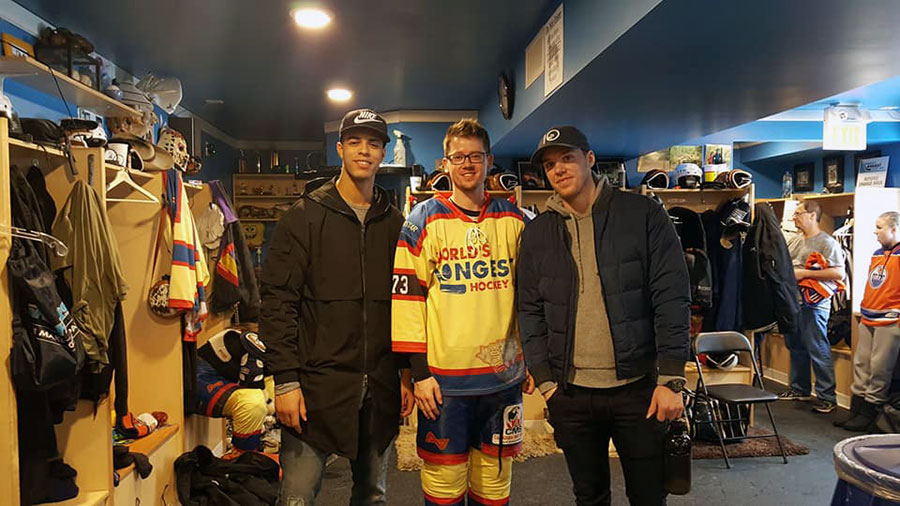Alum endures 10 days on the ice to raise money for pediatric cancer research
For Adam Humeniuk and 39 other hockey players, Feb. 19 brought an emotional end to 10 long, cold days.
As the teams skated to a stop at the outdoor rink at Saiker’s Acres near Sherwood Park, the audience of roughly 100 spectators erupted into cheers. A new Guinness World Record had been set: the world’s longest hockey game had come to an end after 251 hours straight.
The challenge was about more than just setting a new record, though. The game, which took more than 10 days to play, raised close to $1.2 million to support pediatric cancer research.
This was the third time Humeniuk (Civil Engineering Technology ’13) played for the fundraiser, which has been held six times since 2003 and raised $4.6 million.
“It’s a special thing, especially if you have someone who has battled cancer,” says Humeniuk, who was also part of the 2013 game, which set a record of 242 hours, and the 250-hour hockey marathon in 2015.
“It’s a special thing, especially if you have someone who has battled cancer.”
Spending 10 consecutive days on the ice during one of the coldest months of the year is an experience of highs and lows, including meeting people from across Alberta who came out to cheer the teams on, and playing through injuries and barely sleeping. We asked Humeniuk to tell us how he did it and what he’s learned from being a part of these record-setting games.
 Surviving the Alberta winter
Surviving the Alberta winter
One day, temperatures dipped past minus 30 C. A few days later, players were hit with freezing rain.
The cold was easier to handle. Humeniuk (pictured nearby, lacing up) wore skates large enough to fit two pairs of socks. However, measures to keep warm went beyond the ordinary on particularly cold days.
“I would also put toe warmers in my skates,” says Humeniuk. “But on top of all that, I used large boot liners on the outside of my skate. I cut the bottoms so that the blade could go through then I would tape them around my skate.”
Extreme aches and pains
Players dealt with everything from risk of frostbite to aching joints to pulled muscles. For Humeniuk, the first few days were the hardest, with his muscles begging for a break at the end of each shift – of four to seven hours (two per day, one of them often at three or four a.m.).
“The very first shift you play feels extremely long,” he says. “It’s tough at first then your body starts to adjust.”
Chiropractors, nurses and massage therapists were among the hundreds of volunteers on site (the Guinness rulebook prevents players from leaving for any reason). Between shifts, Humeniuk and the other players took breaks and slept (or tried to) in nearby trailers.
“I think the maximum amount of sleep I had is five hours. I know some of the players had trouble sleeping and a lot of them are in pain. Even myself, you get the sweats at night, just from the change in temperature in our bodies.”
The mental game

Humeniuk was prepared for the cold weather and the physical demands on his body but he was surprised by the mental impact the long hours had on him. He admits there were times at the beginning when he felt like going home.
Keeping the end goal in mind kept him motivated, and those thoughts had nearly vanished by the time the game had reached its midway point.
Meeting the people who went out to Saiker’s Acres to show their support also strengthened his resolve. “Having people who are currently battling cancer or have battled cancer coming out, having strangers thanking me and hugging me, was really special.”
Some of those visitors included Edmonton Oilers players Connor McDavid, Darnell Nurse and Ryan Nugent-Hopkins – a moment Humeniuk can only describe as surreal.
During those cold late-night hours, however, he and the rest of the team mostly relied on each other.
“We had fun on the ice together. We had each other to lift our spirits up.”
Worth every minute
At the toughest times, says Humeniuk, “The only thing that can really motivate you is remembering why you are doing it and enjoying your time with the guys.”
Reflecting on the extreme cold and the physical and mental challenges, he finds lessons in them. For one, he realized that he had the capacity to push himself to the end.
Now that he’s had the chance to recover, he says he would do it all over again if meant playing alongside his teammates to support people battling cancer. In fact, he already plans to be part of the next fundraiser.
“It was worth every minute for how much the money raised will help people,” says Humeniuk. “So we are going to keep doing it every few years.”